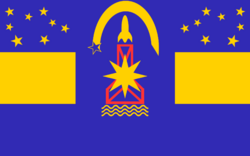Calderan Space Program
This article is non-canonical either because it refers to out-of-character content, the associated nations have left the region, or the information has been retconned. Accordingly, its content should not be considered to be part of the canonical structure of the region's lore.
|
The Ceuldisches Weltraumprogramm (Ænglish: Calderan Space Program) is the newest Calderan government agency created by the Volkspartei in an effort to prioritize space travel and spread Calderan nationalism to space. Prior to the 28th of September 2033, the Calderan Space Program was part of the Calderan Armed Forces, as any sort of space exploration was done by the CAF's research and development division. The Calderan Space Program is unique in that it is the only government agency that will often use Ænglish in place of Gothic.
 | |
| Agency overview | |
|---|---|
| Nickname | CSP |
| Formed | 28 September 2033 |
| Preceding agency |
|
| Type | Space agency |
| Headquarters | Neu Maessen, Austro-Caldera |
| Motto | "To claim the stars" |
| Official languages | Gothic Ænglish |
Overseer | Pen Kein |
History
The Spirit of Adventure
The very first Gothic immigrants to Austro-Caldera were often explorers, as they had to sail for days to make the trip, and must have had the spirit of adventure in order to be so brave to voyage. The first Volkspartei government wanted to honor this tradition by funding cartographers, but overtime, there wasn't any more land to explore, and the Calderan spirit of adventure fell into history.
After the Second Great War, Calderan scientists working for the armed forces detailed to Volkspartei representatives how Caldera should fund efforts to reach outer space. With the Calderan Space Program becoming a formal branch of the CAF research and development division, Caldera slowly became a space capable nation with the first manned flight occurring on June 4th, 1968.
Rocket Development
The Calderan Space Program was the least funded CAF project team, having slightly less funding than the Food and Nourishment Program. Due to this, it would take decades for the CSP to make any significant advancements into space flight, and this led to scientists having to focus on only 1 small project to develop for years before moving onto another. The CSP decided that for ease of use, the program would use normal rockets for intercontinental ballistic missiles and modify them slightly to make them space suitable. This resulted in the unique development of a frame that fits over a standard CLI-58 rocket which helps increase fuel capacity and allows the instillation of a cockpit in between two CLI-58 rockets. This frame is called "RF-1", and was the most important part of the space program until the 1990s, when it was phased out for the RF-2 frame which allowed the mounting of larger rockets.
In 1978, the Calderan Space Program launched a CLI-75 rocket testing the rocket speed of 100,000 miles per hour. The test was successful, and the rocket left Ixnay and traveled in space for about 6 months until the rocket came into orbit around a large gas planet where it remains in orbit to this day.
Landing on the Moon
The Calderan Space Program didn't successfully land the first Calderan on the Moon until July 26th, 1984, when MO-07 spacecraft pilot Captain Jeihf Einhorn led Project Forward to plant a Calderan flag on the Moon. The event was heavily televised and celebrated throughout Caldera, but public interest in space quickly faltered, and the CSP hasn't landed a man on the moon since. The city of Little Caldera still celebrates the event with a parade every July 26th, and the remaining parts of the MO-07 spacecraft are on display at the Calderan Space Museum in Neu Maessen.
Interplanetary Exploration
After the successful moon landing, the Calderan Space Program set its sights on far horizons, and began heavily researching travel to new planets, though it hadn't made much progress in 50 years, the CSP's split into an independent agency increased its funding and its estimated that the first manned space plane will make interplanetary flight in 2038.
Split from Calderan Armed Forces
Negotiations between Austro-Caldera and Vallejar about space travel led to Prime Leader Vandal ordering the Volkspartei to publish pro-space propaganda and spread the spirit of adventure to the average Calderan so the country would be excited to move into a future of countries claiming planets, with Austro-Caldera at its top. As part of this, the Calderan Space Program was separated from the Calderan Armed Forces and its funding was increased dramatically, a 40000% increase from the year prior. In order to allocate funds, Prime Leader Vandal also lowered funding to all CAF R&D programs except to firearms development, in order to maintain funding to Lachsen.
Current Missions
Since its separation from the CAF recently, the CSP has yet to announce any new missions, but it did carry over its old missions from the Armed Forces
Stitch
Stitch is an attempt to create a form of repair station and launchpad from Ixnay's moon. The mission was on hold for years but has now been placed in priority with higher funding.
Elevator
Elevator is the lowest priority mission with the goal of establishing a working spacecraft line that consistently travels to and from the moon. The completion of this mission would drum up funding with tourists joining and paying for luxury stays on the moon, but this mission could not be completed before the Premiere Village mission.
Premiere Village
Premiere Village is the agency's long term plan of establishing permanent Calderan presence on the moon with a form of interstellar commerce.